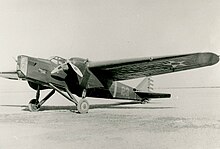| XB-8 | |
|---|---|
 XB-8 prototype XB-8 prototype | |
| General information | |
| Type | Bomber |
| Manufacturer | General Aviation Corporation. |
| Designer | Fokker |
| Primary user | United States Army Air Corps |
| Number built | 7 (1 XB-8 + 2 YB-8 + 4 Y1B-8), all as Y1O-27 |
| History | |
| First flight | 20 October 1930 as XO-27, February 1931 as XB-8 |
The Fokker XB-8 was a bomber built for the United States Army Air Corps in the 1930s, derived from the high-speed Fokker O-27 observation aircraft.
Design and development

During assembly, the second prototype XO-27 was converted to a bomber prototype, dubbed the XB-8. While the XB-8 was much faster than existing biplane bombers, it did not have the bomb capacity to be considered for production. Two YB-8s and 4 Y1B-8s were ordered, but these were changed mid-production to Y1O-27 configuration.
The wing of the XB-8 and XO-27 was built entirely from wood, although the fuselage was constructed of steel tubes covered with fabric with the exception of the nose which had a corrugated metal. They featured the first retractable landing gear ever fitted to an Army Air Corps bomber or observation craft. The undercarriage retracted electrically. The crew was three in tandem position.
Operational history
It competed against the Douglas Y1B-7/XO-36. Both promised to greatly exceed the performance of the large biplane bombers then used by the Army Air Corps. However, the Douglas XB-7 was markedly better in performance than the XB-8, and no further versions of Fokker's aircraft were built.
Operators
Specifications (XB-8)
Data from Fokker's Twilight.
General characteristics
- Crew: 4
- Length: 47 ft 4 in (14.42 m)
- Wingspan: 64 ft 4 in (19.60 m)
- Height: 11 ft 6 in (3.50 m)
- Wing area: 619 sq ft (57.5 m)
- Empty weight: 6,861 lb (3,112 kg)
- Gross weight: 10,650 lb (4,824 kg)
- Powerplant: 2 × Curtiss V-1570-23 "Conqueror" V12 engines, 600 hp (450 kW) each
Performance
- Maximum speed: 160 mph (260 km/h, 140 kn)
See also
Aircraft of comparable role, configuration, and era
Related lists
References
Notes
Bibliography
- Cellier, Alfred (23 August 1934). "American Military Monoplanes". Flight. Vol. XXVI, no. 1339. pp. 862–865. Retrieved 9 January 2024.
- Pelletier, Alain J. "Fokker Twilight". Air Enthusiast, No. 117, May/June 2005, pp. 62–66. ISSN 0143-5450.
- Wagner, Ray. American Combat Planes. New York: Doubleday, 1982. ISBN 0-930083-17-2.
External links
- O-27 USAAS 1000 Aircraft Photos
- Army's Mystery Plane Passes Speed Test – Popular Science
- Atlantic (Fokker) XB-8 – National Museum of the US Air Force
| Fokker aircraft | |||||||||||||||||||||||
|---|---|---|---|---|---|---|---|---|---|---|---|---|---|---|---|---|---|---|---|---|---|---|---|
| Company designations pre-1918 | |||||||||||||||||||||||
| Austro-Hungarian military designations | |||||||||||||||||||||||
| German military designations | |||||||||||||||||||||||
| Company designations post-1918 |
| ||||||||||||||||||||||
| Atlantic Aircraft (Fokker America/Atlantic-Fokker) | |||||||||||||||||||||||
| United States military designations |
| ||||||||||||||||||||||
| USAAS/USAAC/USAAF/USAF bomber designations, Army/Air Force and Tri-Service systems | |||||||
|---|---|---|---|---|---|---|---|
| Original sequences (1924–1930) |
| ||||||
| Main sequence (1930–1962) |
| ||||||
| Long-range bomber (1935–1936) | |||||||
| Tri-Service sequence (1962–current) | |||||||
| Non-sequential |
| ||||||
| United States observation aircraft designations, USAAC/USAAF and Tri-Service systems | |||
|---|---|---|---|
| USAAC/USAAF sequence (1924–1942) |
| ||
| Tri-Service sequence (1962–present) |
| ||
| Unconfirmed | |||